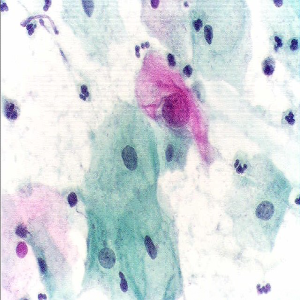Prevalence of positive “Pap” smears and psychological experience among post-natal women in a tertiary health center in Kano, Nigeria

All claims expressed in this article are solely those of the authors and do not necessarily represent those of their affiliated organizations, or those of the publisher, the editors and the reviewers. Any product that may be evaluated in this article or claim that may be made by its manufacturer is not guaranteed or endorsed by the publisher.
Authors
Cervical cancer is a preventable and curable disease if diagnosed early, as it has a well-evaluated natural history. Cervical screening has been associated with a 74% reduction in the incidence of cervical cancer. The study aimed to evaluate the prevalence of abnormal “Pap tests” in post-natal patients and the psychological experience of patients undergoing “Pap tests”. This was a cross-sectional study. All newly registered post-natal patients who are sexually active and at least 3 years after sexual debut, from the age of 18 years and up to 49 years, and who gave consent were recruited for the study. One hundred and fifty-four (154) women, who completed six weeks post-partum, were recruited from October 1 to November 1, 2019. The majority of the patients were in the age group of 29-39 years, 75 (48.7%). The age ranged between 18 and 49 years, with a mean age of 34.24 years ± 6.957 SD. The mean age of marriage was 19.99 years ± 5.287 SD. The age of coitarche was 10-35 years, and 105 participants (68.18%) had their first sexual contact before the age of 20 years. The “pap” smear results were positive in 3 (1.95%) patients: Low-Grade Squamous Intraepithelial Lesion (LSIL) was found in 2 (1.30%), and High-Grade Squamous Intraepithelial Lesion (HSIL) in 1 (0.65%) patient. The prevalence of positive pap smears in post-natal patients was 1.9%. The majority of women were anxious, 78 (50.65%), and depressed, 88 (57.14%), prior to evaluation. However, no statistical association was found between risk factors, anxiety, and the number of positive smears in our sample group. A statistically significant difference was observed between anxiety and “Pap-test” by age, parity, and a statistically significant association by source of awareness in this study. Anxiety is the common reaction to any procedure, investigation or delivery of results. An abnormal response needs additional support, counseling, follow-up, and a clear explanation of the plan of management. Patients with high anxiety scores will benefit from multidisciplinary management.
How to Cite

This work is licensed under a Creative Commons Attribution-NonCommercial 4.0 International License.
PAGEPress has chosen to apply the Creative Commons Attribution NonCommercial 4.0 International License (CC BY-NC 4.0) to all manuscripts to be published.

 https://doi.org/10.4081/pjm.2023.342
https://doi.org/10.4081/pjm.2023.342



